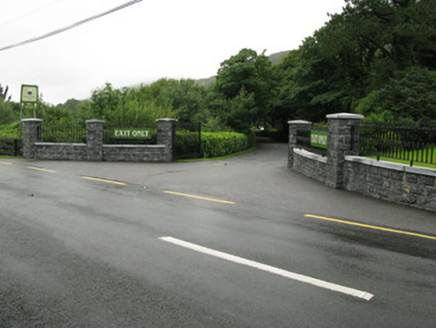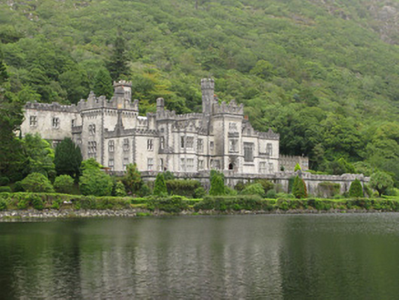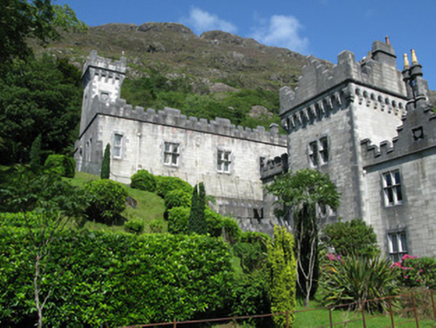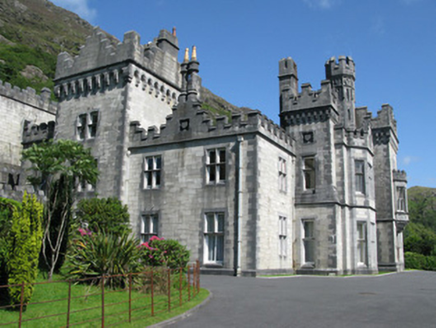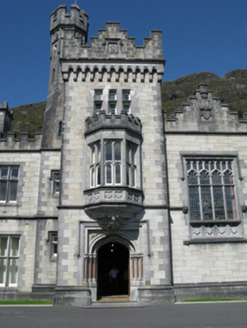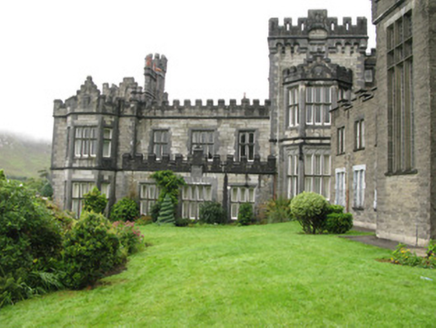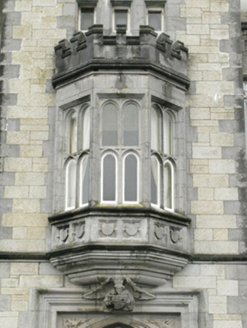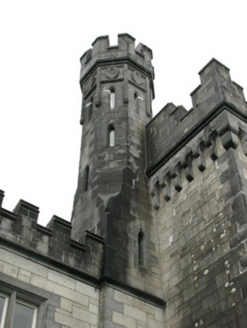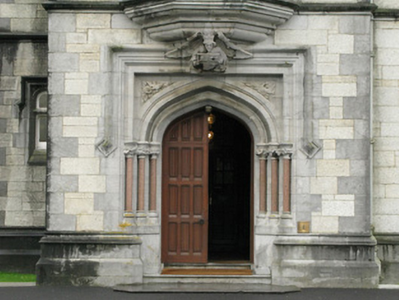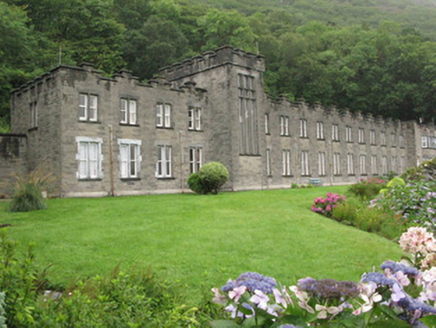Survey Data
Reg No
30402306
Rating
International
Categories of Special Interest
Architectural, Artistic, Historical, Social
Previous Name
Kylemore Castle
Original Use
Country house
In Use As
School
Date
1860 - 1875
Coordinates
74864, 258501
Date Recorded
28/08/2008
Date Updated
--/--/--
Description
Freestanding irregular-plan country house, built 1864-71. Seven-bay mainly two-storey front block faces south having stepped plan, projecting off-centre three-storey entrance bay with three-stage octagonal turret to rear and oriel window over entrance, canted west-end bay, double-height bay to east side of tower and narrow bay to west side and flat-roofed single bay to front of one of east end bays. Four-bay two-storey west elevation has single-bay three-storey tower. Attached four-bay three-storey block built into hillside to north-west of front block with single-stage tower. Four-bay two-storey east elevation to main block has full-height canted-bay to south and three-bay single-storey projection forward of other bays, and three-storey L-plan block attached to rear and presenting three-storey tower to east to continue east elevation of front block and having two-storey canted bay. Double-pile two-bay two-storey attached block to north attached to main house via two-storey corridor. Seventeen-bay two-storey school/convent block to east, built c.1920, attached by recent gated wall, having higher projecting stairs tower towards west end and canted east end bay. Single and two-storey blocks to courtyard area and multiple-bay recent extension and additions to rear elevations of main house and school/convent block. Flat felt roofs with lead flashings and pitched slate roofs to house, ashlar limestone crenellated parapets throughout with tooled chamfered limestone copings concealing lead-lined gutters with cast-iron downpipes. Ashlar limestone triple, double and single flue chimneystacks to pitched roof sections of main house with rendered chimneystacks elsewhere. Single-pitch metal roof to north-west block having uPVC rainwater goods. Double-pile hipped slate roofs to attached block to north having rendered crenellated parapet and cast-iron rainwater goods. Pitched and hipped slate, lead-lined flat and lead-lined single-pitch roofs with roof-lights to courtyard blocks with variety of original cast-iron and replacement uPVC and metal rainwater goods. Snecked ashlar limestone parapets to north-east L-plan block having tooled chamfered limestone copings, concealed gutters and cast-iron rainwater goods, roof covering not visible. Crenellated limestone parapets to eastern school/convent block with chamfered coping stones, roof not visible, having cast-iron down pipes. Limestone crenellated parapets to bay windows, oriel and to single-storey section to east elevation. Tooled shield motif repeated throughout parapets of main house, usually located within limestone surrounded quatrefoil recess. Snecked ashlar Dalkey granite walls to house (all blocks) with tooled chamfered limestone plinth. Tooled limestone quoin stones to corners with occasional lean-to buttresses of limestone. Tooled limestone eaves courses below parapets of various blocks with decorative arcade device to tooled limestone eaves courses to entrance bay and to three-storey west block. Tooled limestone string course to first floor of front and east elevations having occasional foliate label stops at windows. Recent render to some walls to courtyard area, artificial slate weather cladding to east and south elevations of double-pile block. Snecked course stone cladding to school/convent block with rendered flush plinth, rendered walls to rear elevation additions and extensions. Roll moulded limestone corbelling to oriel window over entrance with carved limestone angel to base, limestone aprons below window openings with quatrefoil recesses and shield motif device, ashlar limestone elsewhere. Square-headed single, bipartite, tripartite and quadripartite window openings to house having tooled limestone block-and-start surrounds, chamfered sills, transoms and mullions and with label-mouldings to hall, ground floor of tower to north end of east elevation and to narrow bay next to entrance bay, with replacement timber windows. Round-headed tooled limestone tracery to oriel and some front elevation windows within square-headed openings. Occasional replacement uPVC windows to interior walls of courtyard area. Square-headed four-light window to front elevation of hall, within tooled limestone block-and-start surround with chamfered sill, apron having shield motif to square panels, tooled limestone reticulated tracery to window having lead-lined lattice windows. Single and bipartite square-headed window openings to north-western block having ashlar limestone block-and-start surrounds, chamfered sills, lintels and replacement one-over-one pane timber sliding sash windows to front and replacement uPVC windows to rear elevation. Lancet window openings to turret of entrance tower having tooled limestone surrounds and sills with fixed single-pane windows. Bipartite square-headed window openings to school/convent block having ashlar limestone block-and-start surrounds, mullions and sills, and one-over-one pane timber sliding sash windows, with replacement uPVC windows to canted bays. Two-storey tripartite square-headed window opening to higher bay, having tooled surround, sill, mullions and transoms and containing nine-pane lead-lined lattice windows with stained-glass margins and central panel. Tudor-arch door opening to entrance bay having tooled ashlar limestone block-and-start surround and tooled hood-moulding, housing square-headed recess with carved decoration to spandrels flanking Order arch with three red marble colonettes with foliate capitals. Ashlar limestone steps to approach with ornate timber panelled double-leaf door. Square-headed door openings to side and rear elevations to ground and first floors, latter accessed via recent steel and timber stairways, having battened timber, replacement uPVC and timber glazed doors. Tudor archway to south elevation of western courtyard having ashlar limestone surround and voussoirs with replacement battened timber doors. Square-headed door openings to school/convent block having stone and render surrounds with replacement single and double-leaf battened timber doors. Located in extensive grounds with Pollacappul Lough to south with recent gates to south having rusticated limestone gate piers and wrought-iron double-leaf gates.
Appraisal
Located on the site of Kylemore Lodge, this magnificent building is an internationally famous icon of the west of Ireland. It was built at the behest of Mitchell Henry, MP of Manchester with the original designs being the work of Samuel Ussher Roberts. The castle was completed in 1871 but was added to by the Duke and Duchess of Manchester who purchased the castle in 1903. The architectural design of the building is a curious combination of medieval elements, especially Gothic, which has created an aesthetically pleasing result. There is a high level of craftsmanship displayed in the stonework throughout the house, demonstrating the affluence of those who commissioned its construction, although the use of granite from Dalkey, Co. Dublin made the construction ruinously expensive. The building and its grounds have been maintained to a high standard by the Benedictine Order of nuns who also run a school on the property.
